Caring for a patient with dementia and arthritis who is at risk of injury
Added on 2023-06-12
21 Pages5580 Words182 Views
URN: QUT174801 | PATIENT: SIMPSON,
Ethel Merle
This case study is based on Mrs. Ethel Simpson who is 64 years old. She attends
the pre-admission clinic with her grand-daughter to discuss her up-coming left
knee arthroplasty. Later, she undergoes the surgery and is then three days post-
operative, in the orthopaedic ward.
You will need to access the Mrs Simpson Simulation Case Study resource in your
Blackboard site to view medical documents and the three videos that tell the story
of Mrs Simpson.
Ethel Merle
This case study is based on Mrs. Ethel Simpson who is 64 years old. She attends
the pre-admission clinic with her grand-daughter to discuss her up-coming left
knee arthroplasty. Later, she undergoes the surgery and is then three days post-
operative, in the orthopaedic ward.
You will need to access the Mrs Simpson Simulation Case Study resource in your
Blackboard site to view medical documents and the three videos that tell the story
of Mrs Simpson.
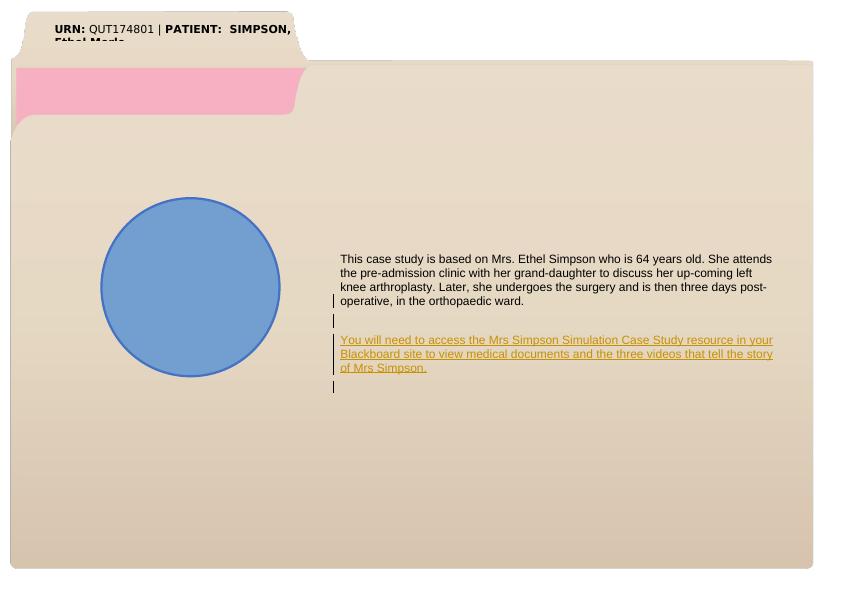
Caring for a patient with dementia and arthritis who is at risk of injury
Setting the scene
Social:
Ethel is 64 years old and lives in a Granny flat attached to her daughter’s
home. She has good support from this daughter and grand-daughter, and
her other two children who visit at least weekly. She was previously a
registered nurse. She has six steps in her house that she needs to
negotiate. Her worsening arthritis, particularly the arthritis in her left knee has
made it extremely difficult for her to leave the house in the last two months.
Ethel complains of poor appetite, difficulty sleeping and not wanting to leave the
house.
Ethel was diagnosed with Alzheimer’s dementia a year ago and has been partially independent in all
her basic activities of daily living. She is continent but needs assistance with bathing and household
activities such as cleaning. She can cook basic meals and feed herself. Cognitively she is oriented to
person, place and year. She can recall 3 out of 3 words immediately, but 0 out of 3 words at 5 minutes.
Her attention is intact.
Mrs Simpson and her family sought advice from her GP because of the worsening pain of her arthritis,
particularly in her knee and the impact this was having on her mobility. After being referred to an
orthopaedic surgeon for review, the decision was made for a knee arthroplasty to be done.
Epidemiology / pathophysiology of disease processes
The National Health Priority Areas of Arthritis and Musculoskeletal conditions, Dementia and Injury
Prevention and Control were established with the aim of improving health outcomes in these areas.
Musculoskeletal conditions are conditions of the bones, muscles and their attachments (e.g. joints and
ligaments). Osteoarthritis, rheumatoid arthritis and osteoporosis are the most commonly occurring
musculoskeletal conditions. They have substantial influence on the quality of life and impose a heavy
economic burden on the community.
Injuries are adverse effects on the human body. They are a significant source of preventable illness,
disability and premature death in Australia.
Dementia is defined as the loss of mental processing ability, including communication, abstract
thinking, judgment and physical abilities, such that it interferes with daily living. Conditions
associated with dementia are typically progressive, degenerative and irreversible, for which there is
currently no cure.
NSB335 Assessment 3 Page 2 of 21
Setting the scene
Social:
Ethel is 64 years old and lives in a Granny flat attached to her daughter’s
home. She has good support from this daughter and grand-daughter, and
her other two children who visit at least weekly. She was previously a
registered nurse. She has six steps in her house that she needs to
negotiate. Her worsening arthritis, particularly the arthritis in her left knee has
made it extremely difficult for her to leave the house in the last two months.
Ethel complains of poor appetite, difficulty sleeping and not wanting to leave the
house.
Ethel was diagnosed with Alzheimer’s dementia a year ago and has been partially independent in all
her basic activities of daily living. She is continent but needs assistance with bathing and household
activities such as cleaning. She can cook basic meals and feed herself. Cognitively she is oriented to
person, place and year. She can recall 3 out of 3 words immediately, but 0 out of 3 words at 5 minutes.
Her attention is intact.
Mrs Simpson and her family sought advice from her GP because of the worsening pain of her arthritis,
particularly in her knee and the impact this was having on her mobility. After being referred to an
orthopaedic surgeon for review, the decision was made for a knee arthroplasty to be done.
Epidemiology / pathophysiology of disease processes
The National Health Priority Areas of Arthritis and Musculoskeletal conditions, Dementia and Injury
Prevention and Control were established with the aim of improving health outcomes in these areas.
Musculoskeletal conditions are conditions of the bones, muscles and their attachments (e.g. joints and
ligaments). Osteoarthritis, rheumatoid arthritis and osteoporosis are the most commonly occurring
musculoskeletal conditions. They have substantial influence on the quality of life and impose a heavy
economic burden on the community.
Injuries are adverse effects on the human body. They are a significant source of preventable illness,
disability and premature death in Australia.
Dementia is defined as the loss of mental processing ability, including communication, abstract
thinking, judgment and physical abilities, such that it interferes with daily living. Conditions
associated with dementia are typically progressive, degenerative and irreversible, for which there is
currently no cure.
NSB335 Assessment 3 Page 2 of 21
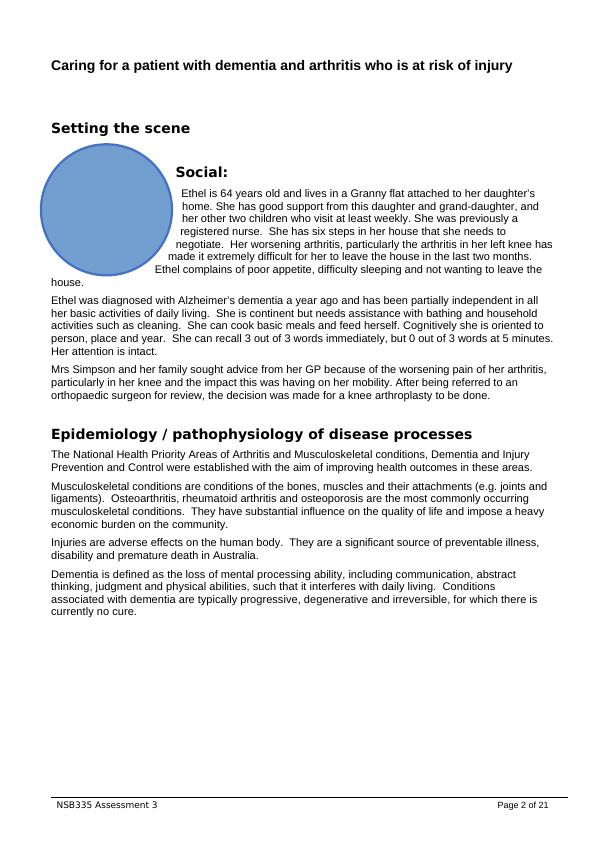
Your Task:
Use the Clinical Reasoning Cycle on the following pages to review the nursing priorities in relation to
the care of Ethel.
NSB335 Assessment 3 Page 3 of 21
Use the Clinical Reasoning Cycle on the following pages to review the nursing priorities in relation to
the care of Ethel.
NSB335 Assessment 3 Page 3 of 21
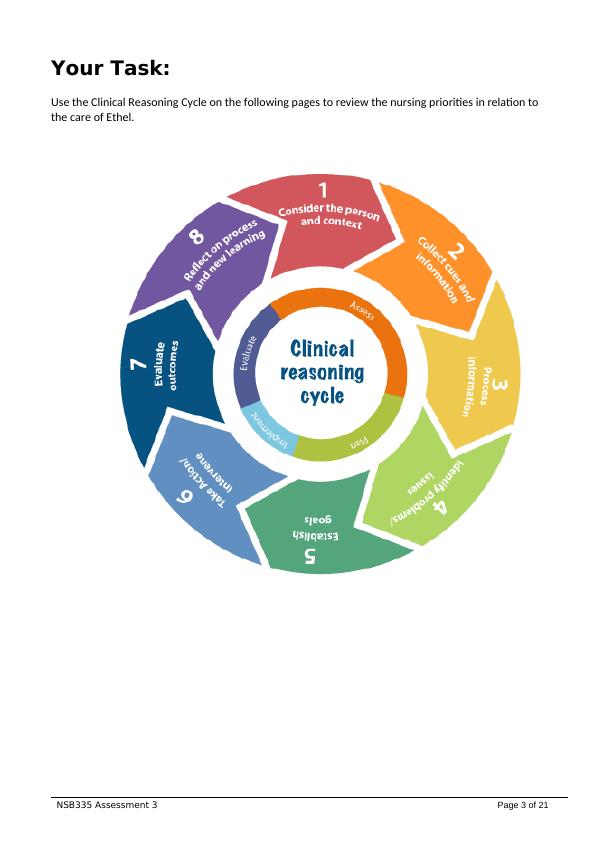
Watch the two videos – Pre-admission Clinic and At home
Gain an initial impression of
your patient
Question 1:
Review the anatomy and physiology of the three
musculoskeletal conditions listed above (osteoarthritis,
rheumatoid arthritis and osteoporosis).
What type of arthritis do you think that Ethel has?
Explain the rationale for your answer.
Your Answer:
Osteoarthritis is a common arthritis that targets the elderly patient population, The
anatomical and patho-physiological features include break\down and
eventual loss of cartilage or more joints (Hochberg et al., 2012, pp. 465-474).
Rheumatoid arthritis is a autoimmune disorder where the immune system of the
patient facilitates the targeting of the lining of the joints giving rise to
inflammation.
Osteoporosis is a condition of the fragile bones with increased susceptibility to
fracture.
The patient in this case is suffering from Osteoarthritis.
As the patient is 64 years old and is going to be undergoing arthoplasty which is a
common surgical intervention for osteoarthritis, she is suffering from osteoarthritis
(Hochberg et al., 2012, pp. 465-474). Apart from old age, obesity, women gender,
knee injury and muscle weakness also increases the risk of osteoarthritis. As Ethel
belongs to the female sex and females have high density of adipose derive leptin
concentration, she is regarded to be suffering from osteoarthritis (Heidari, 2015, pp.
205–212).
Gain an initial
impression of your
Question 2:
List three variables that put Ethel at risk of injury. Justify your
answer.
NSB335 Assessment 3 Page 4 of 21
Gain an initial impression of
your patient
Question 1:
Review the anatomy and physiology of the three
musculoskeletal conditions listed above (osteoarthritis,
rheumatoid arthritis and osteoporosis).
What type of arthritis do you think that Ethel has?
Explain the rationale for your answer.
Your Answer:
Osteoarthritis is a common arthritis that targets the elderly patient population, The
anatomical and patho-physiological features include break\down and
eventual loss of cartilage or more joints (Hochberg et al., 2012, pp. 465-474).
Rheumatoid arthritis is a autoimmune disorder where the immune system of the
patient facilitates the targeting of the lining of the joints giving rise to
inflammation.
Osteoporosis is a condition of the fragile bones with increased susceptibility to
fracture.
The patient in this case is suffering from Osteoarthritis.
As the patient is 64 years old and is going to be undergoing arthoplasty which is a
common surgical intervention for osteoarthritis, she is suffering from osteoarthritis
(Hochberg et al., 2012, pp. 465-474). Apart from old age, obesity, women gender,
knee injury and muscle weakness also increases the risk of osteoarthritis. As Ethel
belongs to the female sex and females have high density of adipose derive leptin
concentration, she is regarded to be suffering from osteoarthritis (Heidari, 2015, pp.
205–212).
Gain an initial
impression of your
Question 2:
List three variables that put Ethel at risk of injury. Justify your
answer.
NSB335 Assessment 3 Page 4 of 21

patient.
Your Answer:
The patient is case study, Ethel, has been suffering from dementia and
osteoarthritis. The three variables that put Ethel at risk of injury includes the
following:
The first factor is her age as she is 64 years old. Ageing increases chance of
injury and risk of fall because of risk of balance impairment and reduced limb
strength due t the natural aging process (Bird et al., 2013, 5989–5997).
The second factor is her mobility restriction due to pain in the left knees. Her
house has six steps that she needs to negotiate and pain in the knees can
lead to injury while using the stairs.
The third variable that increases risk of injury is her dementia. Patients with
dementia are twice likely to fall than elderly people because of neuro-
cognitive disability (Aizen, 2015, pp. 323-326).
Gain an initial
impression of your
patient.
Question 3:
Review and recall knowledge from NSB132 on dementia as it is
important to understand the type of dementia that Ethel has.
What statement best describes Alzheimer’s dementia?
a) Occurs through a reduced blood supply to the brain and
accounts for around 20% of dementia cases.
b) Is associated with Lewy bodies and accounts for around
15% of dementia cases.
c) Is associated with shrinkage/atrophy of the brain and
accounts for around 50% of dementia cases.
d) Is associated with tangled bundles of proteins in brain nerve
cells with an earlier age of onset and accounts for around
5% of dementia cases.
Your Answer:
c.) Is associated with shrinkage/atrophy of the brain and accounts for around 50%
NSB335 Assessment 3 Page 5 of 21
Your Answer:
The patient is case study, Ethel, has been suffering from dementia and
osteoarthritis. The three variables that put Ethel at risk of injury includes the
following:
The first factor is her age as she is 64 years old. Ageing increases chance of
injury and risk of fall because of risk of balance impairment and reduced limb
strength due t the natural aging process (Bird et al., 2013, 5989–5997).
The second factor is her mobility restriction due to pain in the left knees. Her
house has six steps that she needs to negotiate and pain in the knees can
lead to injury while using the stairs.
The third variable that increases risk of injury is her dementia. Patients with
dementia are twice likely to fall than elderly people because of neuro-
cognitive disability (Aizen, 2015, pp. 323-326).
Gain an initial
impression of your
patient.
Question 3:
Review and recall knowledge from NSB132 on dementia as it is
important to understand the type of dementia that Ethel has.
What statement best describes Alzheimer’s dementia?
a) Occurs through a reduced blood supply to the brain and
accounts for around 20% of dementia cases.
b) Is associated with Lewy bodies and accounts for around
15% of dementia cases.
c) Is associated with shrinkage/atrophy of the brain and
accounts for around 50% of dementia cases.
d) Is associated with tangled bundles of proteins in brain nerve
cells with an earlier age of onset and accounts for around
5% of dementia cases.
Your Answer:
c.) Is associated with shrinkage/atrophy of the brain and accounts for around 50%
NSB335 Assessment 3 Page 5 of 21
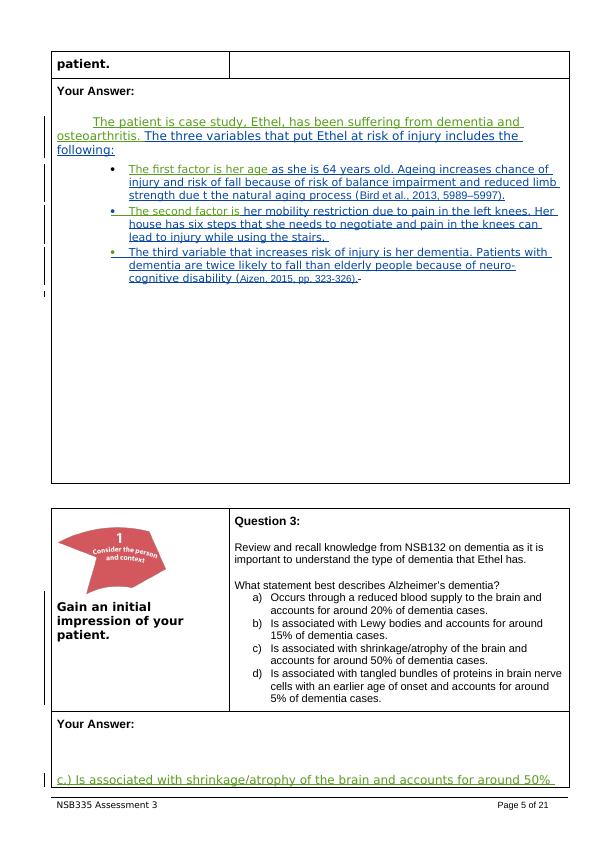
of dementia cases (Johnson et al., 2012, pp. p. a006213)
Gain an initial
impression of your
patient.
Question 4:
Aricept is a commonly used medication to treat mild to moderate
dementia caused by Alzheimer’s disease.
a) Briefly describe the mode of action of this medication for
Ethel (1 mark)
b) How should the medication be taken?
c) List two side effects of the medication
Your Answer:
Aricept or donepezil is a medication given to dementia patient to treat confusion. It
is an enzyme blocker that works to improve memory by restoring the balance of
neurotransmitters in the brain (drugbank.ca, 2018).
Ethel will need to take the medication orally with or without food depending
on the instruction of the medical practitioner caring for the patient. According to
the general administration guidelines for Aricept, Ethel will need to take the
medication once daily before bedtime (Cummings et al., 2016, . . pp. 159-166).
Two side effects that Ethel may experience due to taking Aricept for her
dementia includes: nausea and diarrhea.
Question 5:
When the family first became concerned about Mrs Simpson’s
cognitive status, they visited the GP. She referred Ethel to you as a
practice nurse for a further examination of mental status. There are
many cognitive tools available that you might use.
NSB335 Assessment 3 Page 6 of 21
Gain an initial
impression of your
patient.
Question 4:
Aricept is a commonly used medication to treat mild to moderate
dementia caused by Alzheimer’s disease.
a) Briefly describe the mode of action of this medication for
Ethel (1 mark)
b) How should the medication be taken?
c) List two side effects of the medication
Your Answer:
Aricept or donepezil is a medication given to dementia patient to treat confusion. It
is an enzyme blocker that works to improve memory by restoring the balance of
neurotransmitters in the brain (drugbank.ca, 2018).
Ethel will need to take the medication orally with or without food depending
on the instruction of the medical practitioner caring for the patient. According to
the general administration guidelines for Aricept, Ethel will need to take the
medication once daily before bedtime (Cummings et al., 2016, . . pp. 159-166).
Two side effects that Ethel may experience due to taking Aricept for her
dementia includes: nausea and diarrhea.
Question 5:
When the family first became concerned about Mrs Simpson’s
cognitive status, they visited the GP. She referred Ethel to you as a
practice nurse for a further examination of mental status. There are
many cognitive tools available that you might use.
NSB335 Assessment 3 Page 6 of 21
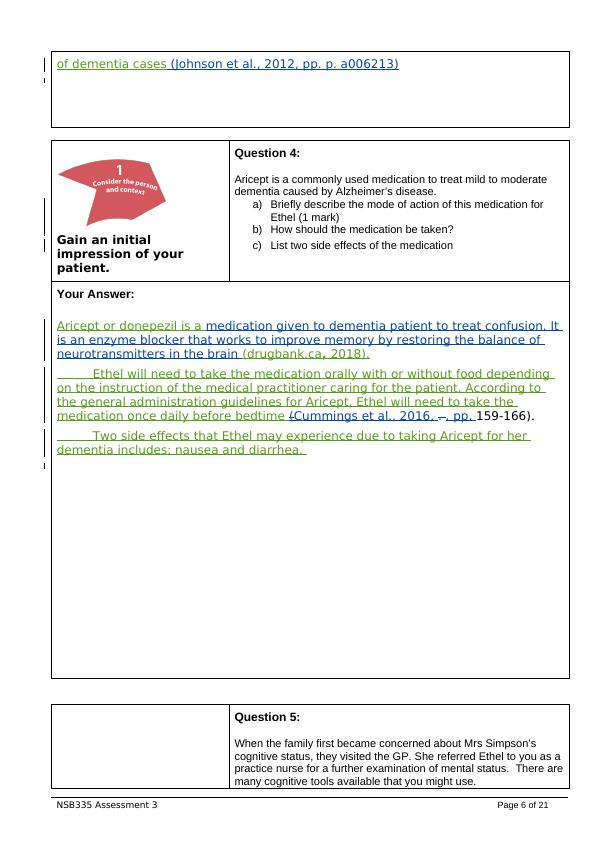
End of preview
Want to access all the pages? Upload your documents or become a member.
Related Documents
Case Study on Mrs. Ethel Simpsonlg...
|16
|4743
|71
Holistic Assessment By General Practitionerlg...
|9
|4683
|23
